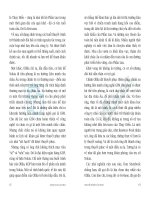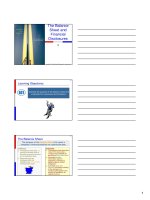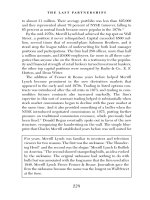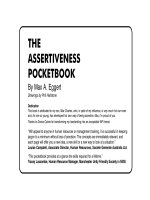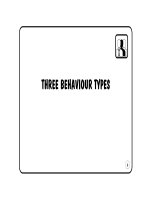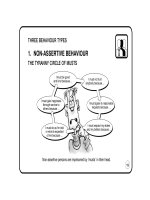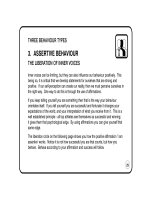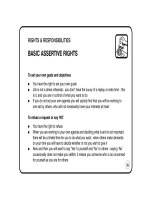THE BALANCE SHEET POCKET BOOK phần 8 pdf
Bạn đang xem bản rút gọn của tài liệu. Xem và tải ngay bản đầy đủ của tài liệu tại đây (82.02 KB, 12 trang )
PROFIT AND LOSS ACCOUNT
PROFIT NOT CASH
ATTRIBUTABLE COSTS
For `Profit’ to be a meaningful measure, ‘like’ has
to be compared with `like’.
DON’T SELL APPLES AND COST PEARS!
Hence Attributable Costs are the
operating costs associated with
producing and delivering the
items sold during the period
NOT
the amount of cash spent
75
PROFIT AND LOSS ACCOUNT
PROFIT NOT CASH
● Goods received, and not yet used for the products that have been sold will appear
as Stock on the Balance Sheet
● Goods received, but not yet paid for will appear under Creditors/Payables on
the Balance Sheet
Example
£100 worth of stock is delivered to your premises
● When it is received: Stock increases by £100 Does not affect
Creditors increase by £100 profit and loss
● When it is paid for: Creditors decrease by £100 Does not affect
Cash decreases by £100 profit and loss
● When it is despatched Stock decreases by £100 Affects profit
to the customer: Attributable cost increases by £100 and loss NOW
76
PROFIT AND LOSS ACCOUNT
PROFIT IS NOT CASH
It is evident, therefore, that whenever a business:
● Holds stock, or
● Gives credit, or
● Takes credit
then profit and cash will not be the same thing.
This debate is examined in more detail in The Managing Cashflow Pocketbook.
77
PROFIT AND LOSS ACCOUNT
OPERATING PROFIT
Profit is measured at various levels down the Statement as additional aspects of
business cost are taken into account.
First consider Operating Profit - the measurement of local operating performance.
This was shown within the model as being:
78
PRO
WORKING CAPITAL
Sales
Attributable Cost
Operating Profit
Interest
Less:
Less:
PROFIT AND LOSS ACCOUNT
OPERATING PROFIT
ATTRIBUTABLE COSTS
The operating (or attributable) costs of the business result from two types of
Revenue Expenditure:
Product-related: Those forming part of the product cost and ultimately the cost
of goods sold
Expenses: Those which relate to the provision of support services, eg:
- selling
- distribution
- R & D
- personnel
- administration, etc
79
PROFIT AND LOSS ACCOUNT
OPERATING PROFIT
ATTRIBUTABLE COSTS
Whilst each company will have its own unique costing system, typically the
division would be:
● Product-related: Material, parts purchased for re-sale, shopfloor labour,
manufacturing expenses (ie: Production Overheads)
● Expenses: All non-manufacturing departmental running costs
The two categories are shown separately on the statement as:
● Cost of goods sold (Product-Related)
● Expenses (sometimes referred to as Support Services)
Product Costing systems are explained in The Managing Budgets Pocketbook.
80
PROFIT AND LOSS ACCOUNT
OPERATING PROFIT
Hence a more detailed statement of Operating Profit would show:
£
Sales 1600
Less:
Cost of goods sold 1000
Gross Profit 600
Less:
Expenses 400
Operating Profit 200
Note:
1 Gross Profit is the difference between the selling price and the cost of manufacturing
the goods sold in the period.
2 Operating Profit is the lowest level in the Profit and Loss Account over which
operational management has control. (This is often referred to as PBIT
Profit Before Interest and Tax or the ‘Bottom Line’).
81
PROFIT AND LOSS ACCOUNT
FINANCING COSTS
After accounting for the operating costs of the business there are other costs
still to be met.
● Interest: Loan interest to be paid in accordance with the contractual
agreement. p14
Note - Interest must be paid whether the company has had a good
year or not, so the greater the loan capital within the business,
the greater the financial risk.
● Tax: Whilst businesses aim to minimise their tax bills by legitimate means
(tax avoidance) the key determinant in the amount paid
will be government fiscal policy.
The profits left over after allowing for Interest and Tax are called Earnings.
82
PROFIT AND LOSS ACCOUNT
EARNINGS
Earnings are what is left after all the business costs have been met.
Earnings, therefore, belong to the shareholders.
Some of the Earnings will be paid out to the shareholder to give them income on their
investment. This is the Dividend.
The rest will be re-invested back within the business enabling the business to grow.
This is the Retained Profit and will be included on the Balance Sheet
as Reserves. p54
83
PROFIT AND LOSS ACCOUNT
DIVIDEND PAYMENT
HOW MUCH DIVIDEND TO PAY
● Retained Profit is the cheapest form of Long-Term Finance, so most companies will
wish to retain as much as possible
● But shareholders expect income as well as growth
● Failure to keep the shareholders happy can result in the removal of the Board of
Directors and/or leave the company vulnerable to takeover bids p11
So the way Earnings are divided
has to be a political decision.
Substantial shareholders, eg,
financial institutions, will prefer
a steady flow of dividend.
Therefore, if Earnings fluctuate
from year-to-year, so will
Retained Profit.
Note that under certain conditions Dividends can even exceed Earnings - resulting in a reduction in Reserves.
84
£
Time
Dividends
Earnings
Increased Reserves
Reduced Reserves
PROFIT AND LOSS ACCOUNT
EXAMPLE - ARC PLC
Profit and Loss Account for the 12 months ending 31st December 200-
£’000 £’000
Sales 1,600
Less: Cost of Goods Sold
Direct Materials 500
Direct Labour 150
Production Overheads 350
1,000
Gross Profit 600
Less: Expenses
Administration 200
Selling 60
Distribution 80
Marketing 60
Total Expenses 400
Net Operating Profit 200
Less: Interest 33
Net Profit Before Tax 167
Less: Ta x 57
Earnings 110
Less: Dividend 30
Retained Profits 80
Note
1 The statement relates to the defined period of time for which the profits or losses are being measured.
2 Cost of Goods Sold is sometimes analysed into the different elements of product cost.
85
1
2
PROFIT AND LOSS ACCOUNT
COST OF GOODS SOLD
An alternative presentation of the Cost of Goods Sold is:
86
£’000
Opening stock of Finished Goods 260
Add:
Finished Goods completed during the period 920
1,180
Less:
Closing Stock of Finished Goods 180
Cost of Goods Sold 1,000
